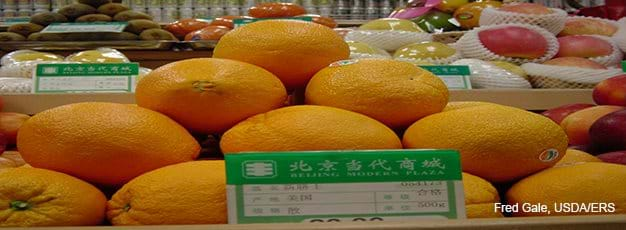Stronger Currency Boosts Chinese Purchasing Power

When converted to U.S. dollars at currentexchange rates, Chinese retail food prices areabout a fourth of the level of U.S. food prices.Prices of vegetables, which constitute a majorportion of most Chinese meals, are as low asa tenth of U.S. prices. The average per capitaurban household income in China—whenconverted to dollars at the official exchangerate—was about $1,600 per year in 2006.With low domestic prices, Chinese consumerscan maintain a comfortable lifestyleon seemingly meager incomes—as long asthey consume domestic foods.
Imported fruits, for example, are usuallyeaten only on special occasions or given asgifts in China. U.S. apples are considered aluxury item because they cost several timesas much as Chinese apples. Cheaper domesticapples are purchased for everyday consumption.
Since the incomes of Chinese consumershave little purchasing power onworld markets, China does not import muchfood. China’s imports have boomed for soybeans,cotton, and vegetable oil, but prices ofmost imported agricultural commodities aretoo high to make major inroads in theChinese market. It has been estimated thatless than 5 percent of items in Chinesesupermarkets are imported.
Appreciation of the Chinese exchangerate may make imports more affordable forChinese consumers. After remaining fixed atabout 8.3 yuan to the U.S. dollar for adecade, the Chinese yuan has been allowedto appreciate gradually since July 2005. Withan ongoing trade surplus, rising foreignexchange reserves, and continuing pressurefrom trade partners, further appreciation ofthe yuan is expected.
Normally, a stronger yuan would makeimports more attractive to Chinese buyers,but a surge in world prices and record-highocean shipping rates have kept imports ofmost grains and meats from being price competitivein China despite the modest currencyappreciation. A much larger currencyappreciation would be needed to makeimports of vegetables, fruits, and processedfoods price competitive. These products haveespecially low prices in China.
Price inflation in China could improvethe price competitiveness of imports withoutan appreciation in the exchange rate, butChina has experienced only moderate, intermittentups and downs in food prices sincethe late 1990s. A sharp increase in porkprices in China during 2007 led to a Chinesecommitment to import U.S. pork during2007-08. However, the rise in Chinese porkprices was more a reflection of cyclical forcesin the hog sector rather than an indicator ofbroad-based inflation. Chinese hog pricesbegan falling in August 2007, as a major diseaseoutbreak was brought under control andfarmers expanded hog inventories inresponse to record-high prices and governmentsubsidies for breeding sows. Chinesecorn and oilseed prices surged in 2006 and2007, but those increases also appear toreflect world market conditions rather thanChinese inflation.
China Currency Appreciation Could Boost U.S. Agricultural Exports, by Fred Gale and Francis Tuan, USDA, Economic Research Service, August 2007
China, by Fred Gale and Jessie Lin, USDA, Economic Research Service, June 2024
China Agricultural and Economic Data, by Fred Gale, USDA, Economic Research Service, August 2019

